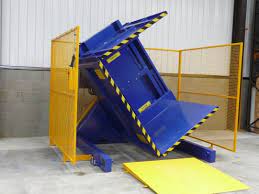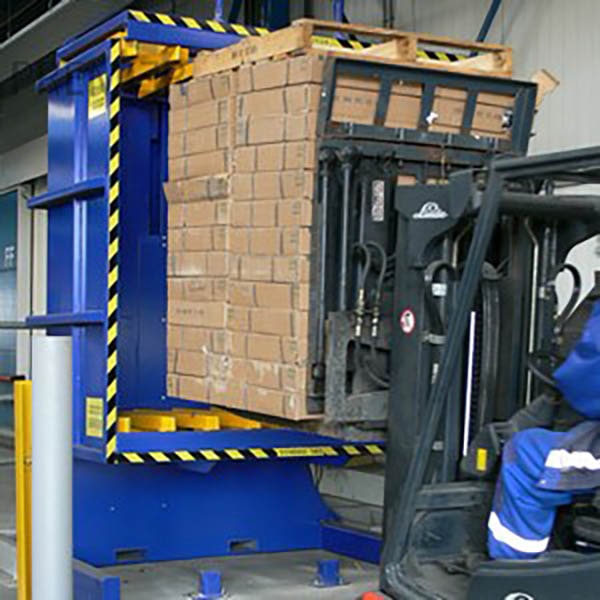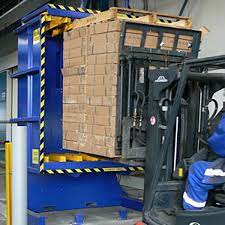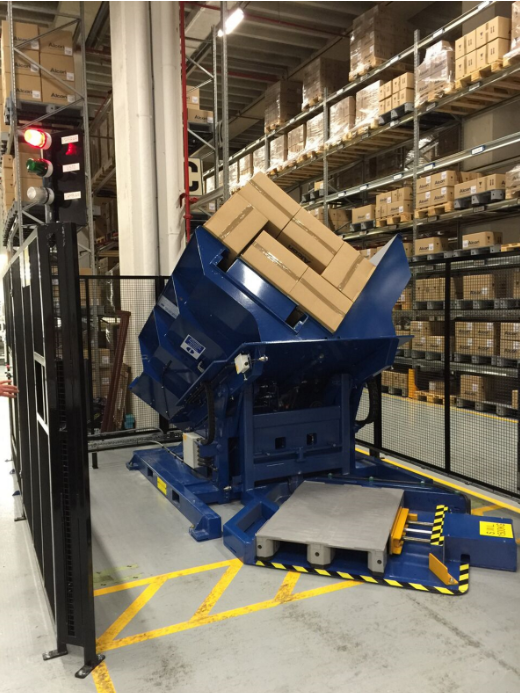Meeting Automation In Busy Meatpacking And Pharma Zones Requirements in Brazil with Automated Pallet Exchange
Are you managing a busy facility in Brazil's meatpacking or pharmaceutical sectors? Then you know the constant pressure. You have to move products quickly, but you also face some of the world's strictest hygiene regulations. The loading dock often becomes a major bottleneck. Wooden pallets, essential for shipping, are forbidden in your clean production areas. This forces your team into slow, risky, manual transfers, creating a point of failure that can lead to contamination, product damage, and costly delays. It feels like you have to choose between speed and safety, a choice no business should have to make.
The solution is to adopt automated pallet exchange systems. These machines are engineered to solve this exact problem by creating a clean, fast, and controlled bridge between your external logistics and your internal clean zones. An automated pallet exchanger seamlessly transfers entire product loads from standard wooden shipping pallets to hygienic plastic or aluminum pallets in minutes, without any manual handling. This single step eliminates a primary contamination risk, ensures compliance with strict regulations like those from ANVISA, and dramatically increases the throughput of your receiving and shipping docks.

This technology is more than just a piece of equipment. It's a fundamental change to your operational philosophy. For leaders like you who are focused on efficiency, cost reduction, and future-proofing your operations, understanding the mechanics and benefits of this automation is critical. It addresses core challenges that are universal across many industries, from food processing in Brazil to steel manufacturing in Mexico. Let's dive deeper into the key questions you should be asking to see if this is the right solution for you.
How Can Automated Pallet Exchange Solve Hygiene and Logistics Headaches in Brazil's Regulated Industries?
Your team works hard to maintain a sterile environment inside the plant. Yet, every single day, goods arrive on wooden pallets that are a known source of contamination. They carry dust, moisture, bacteria, and can even have splinters or nails that pose a physical hazard. This creates a huge headache for your quality assurance team and a constant risk for your business. A single contamination event can lead to rejected shipments, massive product recalls, and severe damage to your brand's reputation. You're caught in a logistical trap, forced to use slow, manual processes just to get goods safely across the cleanroom threshold.
An automated pallet exchange system directly solves these hygiene and logistics challenges by creating a controlled, clean break at the point of entry. It functions as a gateway. On one side, you have your external, non-hygienic shipping pallets. On the other, you have your internal, sanitized production pallets. The machine automatically and gently clamps the product load, inverts or pushes it, and swaps the pallet underneath. This process removes the primary source of pallet-borne contamination from your facility. It also transforms a slow, labor-intensive task into a fast, repeatable, and automated one, breaking the logistics bottleneck for good.

A Deeper Look at the Operational Impact
The challenge in Brazil is twofold. First, you have domestic regulations from agencies like ANVISA, which are incredibly strict about hygiene in food and pharma. Second, if you are an exporter, you must also meet the stringent import requirements of regions like the European Union. These global standards often explicitly forbid the entry of wooden pallets into food processing areas. Relying on manual solutions is not just inefficient; it's a major compliance risk.
Let's break down the transformation. The manual process typically involves:
- Two to three workers surrounding a pallet.
- Manually unstacking boxes or bags onto a nearby clean pallet.
- Risking back injuries from repetitive lifting.
- Potentially damaging packaging or the product itself.
- Taking anywhere from 15 to 30 minutes per pallet.
This manual process is an uncontrolled variable in a business that demands control. An automated system standardizes this entire workflow. The machine performs the same perfect cycle every time, reducing the transfer time to as little as 60-90 seconds. This isn't just a marginal improvement; it's a revolutionary leap in throughput.
Here is a simple comparison to illustrate the difference:
| Metric | Manual Pallet Transfer | Automated Pallet Exchange |
|---|---|---|
| Time per Pallet | 15-30 minutes | 1-2 minutes |
| Required Labor | 2-3 workers | 1 operator (part-time) |
| Contamination Risk | High (direct handling, pallet debris) | Extremely Low (no manual touch, pallet removed) |
| Product Damage Risk | Moderate (dropping, crushing) | Minimal (secure clamping) |
| Ergonomic Safety | Poor (high risk of back injury) | Excellent (no manual lifting) |
| Process Consistency | Low (depends on workers) | High (machine-controlled) |
By automating, you are not just swapping a pallet. You are removing a source of risk, a source of delay, and a source of unnecessary labor costs from your operation. You are creating a more resilient, compliant, and efficient supply chain from the moment goods arrive at your door.
What are the Core ROI Drivers for Investing in a Pallet Exchanger?
As a practical business leader, you look at every investment through the lens of return. A new machine might look impressive, but the numbers have to make sense. You might ask, "How long will it take for this machine to pay for itself?" It's a fair question. If you can't build a strong business case, the project will be stuck on the drawing board, and you'll continue to struggle with the high costs and risks of your current manual process. The good news is that the Return on Investment (ROI) for an automated pallet exchanger is clear, compelling, and comes from multiple sources.
The core ROI drivers for a pallet exchanger are the immediate and significant reductions in operational costs and the avoidance of catastrophic financial risks. The most obvious saving is in labor. You can reassign workers from the dangerous and inefficient task of manual stacking to more value-added roles within the plant. Beyond labor, you will see a dramatic reduction in product damage. The gentle, controlled process of a machine is far safer than manual handling. Finally, the system acts as an insurance policy, helping you avoid the immense costs associated with a product recall, a failed audit, or a shutdown due to contamination.

Breaking Down the Financial Case
When I work with clients, I help them look at the full picture of savings, both the "hard" numbers that are easy to calculate and the "soft" benefits that have strategic value. A thorough analysis makes the decision easy for any financial department.
Hard Savings (Directly on your P&L):
- Labor Cost Reduction: This is the easiest to quantify. Let's say you have two workers dedicated to this task for 8 hours a day. Calculate their total annual salary, including benefits. An automated system needs only one operator, and often that person can manage the machine while doing other tasks. The savings can easily reach tens of thousands of dollars per year.
- Product Damage Elimination: How much product do you lose per year from being dropped, crushed, or damaged during manual transfer? Even a conservative estimate of 1% of product value can be a substantial number for a high-volume facility. A pallet exchanger can reduce this loss by over 90%.
- Reduced Worker Injury Costs: Back injuries from manual lifting are one of the most common workplace incidents. Each incident carries direct costs (medical bills, insurance premium hikes) and indirect costs (lost productivity, temporary staff). Automating the task virtually eliminates this specific risk.
Soft Savings (Strategic & Risk-Aversion):
- Increased Throughput: If you can process incoming goods 10 times faster, what does that mean for your plant? It means trucks spend less time at the dock. It means raw materials get to the production line faster. This directly supports goals like increasing overall plant capacity utilization.
- Compliance & Brand Protection: What is the cost of a single product recall? It can run into the millions, not to mention the irreversible damage to your customers' trust. A pallet exchanger is a preventative measure that ensures you meet hygiene standards every single time.
- Improved Pallet Management: Many companies use pallet pooling services like CHEP or LPR for their expensive, hygienic in-house pallets. A pallet exchanger allows you to keep these valuable assets within your facility, while using simple, low-cost wooden pallets for outbound shipping. This can lead to significant savings on pallet rental and loss fees.
Here's a simplified table to visualize the potential ROI:
| Savings Category | Example Annual Cost (Manual) | Example Annual Cost (Automated) | Annual Savings |
|---|---|---|---|
| Labor Costs | $60,000 | $10,000 | $50,000 |
| Product Damage | $25,000 | $2,000 | $23,000 |
| Worker Injury | $10,000 | $0 | $10,000 |
| Pallet Rental Fees | $20,000 | $15,000 | $5,000 |
| Total | $88,000 |
With numbers like these, a machine with a purchase price of $100,000 to $150,000 can often achieve a payback period of less than two years. For a forward-thinking owner, that's an investment worth making.
Why is Integration with Existing Systems a Critical Factor for Success?
You've analyzed the ROI and decided to invest in an automated pallet exchanger. That's a great step. But simply buying the machine and placing it on your factory floor is not enough. I have seen companies make this mistake. They buy a powerful piece of automation, but it ends up creating a new problem because it doesn't work well with their existing processes. An un-integrated machine becomes an "island of automation," a standalone device that disrupts workflow and requires manual intervention, defeating the very purpose of the investment.
Integration is a critical success factor because a pallet exchanger delivers its maximum value only when it operates as a seamless part of your larger logistics ecosystem. True automation is about flow. The machine must communicate with your other systems, from the physical conveyors that feed it to the warehouse software that directs it. Proper integration ensures that the pallet exchange process is not an interruption but an acceleration of your entire material handling workflow. It transforms the machine from a simple tool into an intelligent node in your smart factory.

The Blueprint for Seamless Integration
When I started my journey as a packing machine engineer, I learned that a successful project is all about the details planned in advance. Thinking about integration from day one is the key. It involves two main areas: physical integration and data integration.
1. Physical Integration:
This is about how the machine physically fits and connects with your existing layout. You need to ask several questions:
- Conveyors: Are the entry and exit points of the pallet exchanger at the same height as your existing conveyor lines? Will the pallets transfer smoothly without getting stuck?
- Layout: Is there enough space for the machine itself, plus safe access for operators and maintenance? Is there a staging area for both the old pallets to be removed and the new pallets to be supplied?
- Safety: How will the machine's safety system connect with the rest of your line? Safety features like light curtains, pressure mats, and emergency stop buttons must be linked to the entire conveyor system. If someone triggers an E-stop, the machine and the conveyors leading to it should all stop instantly.
2. Data & Software Integration:
This is where the machine gets its intelligence. For leaders focused on digitalization, this is crucial.
- Warehouse Management System (WMS/ERP): Can your WMS send an order to the pallet exchanger? For example, the WMS could send a signal with the product ID, confirming that this specific pallet needs to be swapped before it proceeds to Zone A.
- Automation Control: After the swap is complete, the pallet exchanger should send a "task complete" signal back to the WMS. The WMS then updates its inventory record—showing the same product is now on a new pallet ID—and directs the product to its next destination.
- Data Collection (IoT): A modern pallet exchanger is an IoT device. It can collect data on cycle times, uptime, fault codes, and the number of pallets processed. This data can be fed into your Manufacturing Execution System (MES) or analytics platform, giving you real-time visibility into your receiving dock's performance.
I once consulted for a large food company that bought a state-of-the-art pallet exchanger but skipped the integration planning. The machine arrived, but their conveyors were 10 centimeters too low. The software couldn't talk to their German ERP system. The machine sat idle for three months while costly modifications were made. This story is a powerful lesson: planning for integration is not an extra cost; it's the most important investment you can make to guarantee the success of your automation project.
What Are My Personal Insights on Choosing the Right Automation Partner?
Throughout my career, from my first days as an engineer on the factory floor to building my own successful packing machine company, I've learned one lesson that stands above all others: the partner you choose is more important than the machine you buy. The market is filled with suppliers. They all have professional websites and impressive specifications. But when a problem occurs at 2 a.m. and your production line is down, a brochure won't help you. You are not just buying steel and motors; you are entering a long-term relationship.
My most important insight is this: seek a strategic partner, not a transactional supplier. A supplier sells you a box and moves on to the next sale. A partner invests in your success. They start by asking deep questions about your process, your challenges, and your goals. They work with you to design a solution that truly fits, and they stand by you long after the installation is complete. They become an extension of your own engineering team, bringing specialized knowledge that helps you win. That is the kind of relationship that builds successful businesses.

How to Identify a True Partner
When I achieved financial independence thanks to the opportunities this industry gave me, I made it my mission with SHJLPACK to share what I've learned. I want to help people like you make the best possible decisions. Based on my experience both buying and selling equipment, here are the key things I look for in a true automation partner.
1. Deep Technical and Process Knowledge:
A great partner understands more than just their own machine; they understand your world.
- Do they have experience in your specific industry, be it meatpacking, pharma, or even chemicals? Can they show you relevant case studies?
- Do they ask about your product? The weight, the stability of the load, the packaging type? A partner knows that a solution for boxes of medicine is different from a solution for bags of powder.
- Are their engineers willing to talk to your engineers? Open, transparent technical discussion is a sign of a confident and competent partner.
2. A Commitment to Full Lifecycle Support:
The relationship truly begins after the machine is installed.
- Installation & Training: Do they offer on-site installation and comprehensive training for both your operators and your maintenance team? Your team must feel confident running and caring for the equipment.
- Local Support: This is especially crucial in a large country like Brazil. Do they have a local presence or a certified local partner for service and spare parts? Waiting for a part to arrive from Europe or Asia can shut you down for weeks.
- After-Sales Service: What does their support plan look like? Do they offer phone support, remote diagnostics, and a clear warranty? Ask for their standard response time for a service request.
3. A Shared Vision for the Future:
A supplier thinks about today's transaction. A partner thinks about your business in three, five, or ten years.
- Do they talk to you about future trends like predictive maintenance, data analytics, and sustainability?
- Do they design their machines with modularity, allowing for future upgrades as your needs change?
- Are they proactive in offering advice to improve your overall process, even in areas outside their machine's direct function?
I built my company on this philosophy. My goal is to empower you with knowledge so you can see the difference between a simple supplier and a real partner. A partner's success is tied directly to yours.
| Warning Sign (Supplier) | Green Flag (Partner) |
|---|---|
| Focuses only on the machine's price. | Focuses on Total Cost of Ownership (TCO) and ROI. |
| Offers a standard, "one-size-fits-all" solution. | Insists on customizing the solution to your specific needs. |
| Vague about after-sales support details. | Provides a clear, written plan for service, parts, and training. |
| Disappears after the final payment is made. | Schedules regular check-ins to ensure the system is performing. |
Choosing the right partner is the single most important decision you will make in any automation project.
Conclusion
Automating your pallet exchange in demanding zones is more than a compliance fix. It’s a strategic move for unlocking higher efficiency, ensuring robust safety, and paving the way for future growth.





